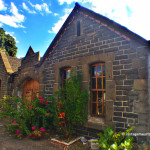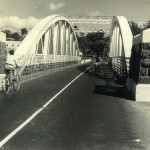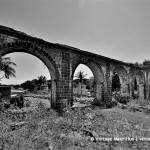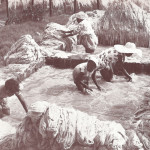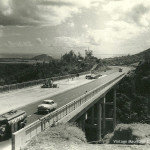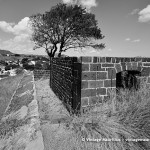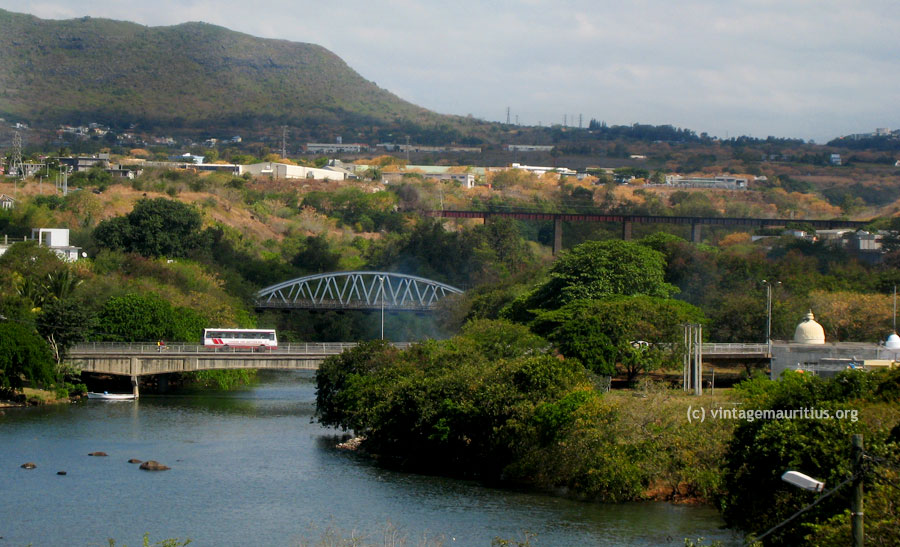
Bridges of Grand River North West
An interesting observation that when viewed from Terrasson/La Tour Koenig, we can see all the 3 bridges of Grand River North West, and had it been kept we would have seen all the 4 bridges but unfortunately the first bridge which was made of iron pillars was demolished. At the far end, the “new” GRNW Railway Bridge, no longer used and abandoned since the last trains of 1964, but still iconic as one of the highest railway bridges constructed in Mauritius. In middle view the GRNW Bridge previously used as main road but now only used and accessed by pedestrians only. Finally, in the foreground, the current bridge of Grand River North West (GRNW), constructed in 1985 and still being used as the Main Road of today.
The First Grand River North West ‘Railway’ Bridge
The First GRNW Railway Bridge was initially constructed with a side-by-side metal pillar architecture but with time and due to accidents, it was found to be unstable and dangerous. It was concluded it wasn’t solid enough and after the accident of 1894 it was petitioned to be rebuilt at a lower level to diminish the danger in case of accidents. Unfortunately this was a too costly investment and also wouldn’t materially solve the problem. Decision was instead taken to strengthen the two cylinders structure by wrapping it with iron sheets and consolidating the in-between with concrete up to 20 feets. This made the bridge more stable, but however, due to the rapid development of traffic, it was necessary to increase the smaller and lighter train engines with bigger ones. The 56 tons engines had to be replaced with 85 tons engines. Problem was, not all the bridges developed round the island could support such new weight, including this GRNW Railway Bridge. A new bridge had to be built.











The Second Grand River North West Railway Bridge
Due to the necessity of a stronger bridge to cater for the heavier train engines, the new GRNW Railway bridge began construction in November 1911 with expectation to be completed in January 1914. The new bridge had stone piers instead of iron compared to the old one and of course, bigger piers. It remained in operation till the mid 60s. It was somehow also believed that the old bridge was still being used for smaller traffic and trains. In some of the pictures below we can still see the first (old) bridge of iron pillars at the back. Point to be noted though… many people think that bridge they are still seeing nowadays (2014) at Coromandel is the 1st Railway bridge… it is not. It is the 2nd one.






The Grand River North West Suspended Bridge
The once magnificent Suspended Bridge of Grand River North West (GRNW) laid its first stone on the 9th January 1837… and was the main access to Port Louis from the West. At that time it was being used mostly by pedestrians & carts as motorised vehicles weren’t yet available. Its structure and architecture was more or less of stone and iron with an arc-style stone pillar on both sides of the bank. With time and age, the bridge was no longer safe and had to be rebuilt differently to cater for the increase in population and traffic of the time. The Suspended Bridge was transformed into a steel bridge.



The Converted Grand River North West Steel Bridge
With the need for a stronger bridge for both pedestrians and motorised traffic, the Suspended Grand River North West Bridge was demolished and rebuilt with a steel structure and shaped to cater for two lanes traffic. The same base of the suspended bridge was converted to a tarred road and was since then used as Main Road to Port Louis up the 1985 where a newer and wider bridge was constructed. This too because the Steel Bridge was too narrow for bigger vehicles and began to show signs of weaknesses. The Bridge is still visible and used today but only accessible by pedestrians and/or two-wheeled transportation.







Click here to locate the Bridge on Google Maps
